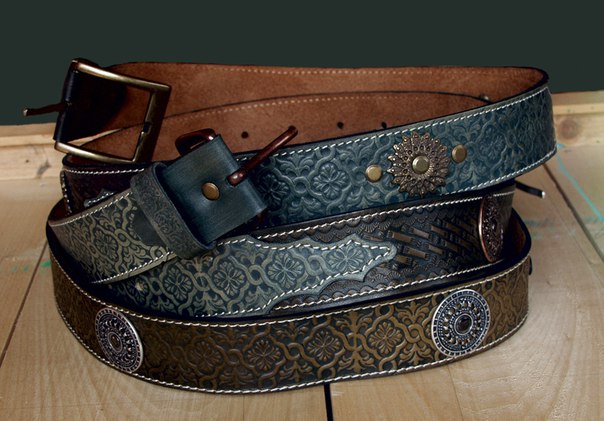
Initial investment: 500 rub.
Monthly profit: 140 tr.
Payback period: 3 months.
Clothing accessories are one of the most interesting segments in the clothing market. On the one hand, the manufacturing process is simple, on the other, the cost of such products is high. What causes this disproportion?
Any accessory is, first of all, jewelry that emphasizes or, conversely, hides certain aspects of outerwear.
Based on this logic, a number of certain requirements, including uniqueness, adherence to a strict style (depending on the main composition), good quality, and so on. All this led to the formation of a kind of “bubble”, that is, a sharp difference between the cost and the actual price. You do not believe
Today we’ll look at a business plan for manufacturing leather belts and using an example you can see how much manufacturers earn.
Why is it profitable to produce leather belts?
One of the most popular accessories in Russia is a belt. Worn this accessory all categories of consumers, from small to large. At the same time, the market configuration is gradually changing. If 5-6 years ago sales could be divided into two conditional categories:
Expensive belts made of genuine leather from European manufacturers;
- cheap products made in China.
Today the situation has changed and the market has begun to actively develop middle segment natural leather belts. The quality of such products is not inferior to their European counterparts, and the price is slightly higher than the Chinese ones.
The emergence of such a niche is facilitated by the growing demand from Russians for unique, high-quality items self made. Actually, the tendency to popularize handmade products is a global trend, and here Russia has just “entered” this path. The practice of the USA and Europe shows that demand will grow by 30-40% annually, which provides the opportunity to create a home mini-business.
In general, business is based on three fundamental things:
Demand – the issue of demand has already been considered, it will grow;
Organization of the process - enough to organize the workplace small room 10-15 square meters and the purchase of several units, and then at will;
Start-up capital - money is needed only for the purchase of raw materials.
The level of profitability of leather belt production varies from 300% to 1000% per product; we’ll talk about the financial part of the business plan below.
What does the technological process look like?
According to the manufacturing technology, leather belts are divided into two types:
The first option is to make a multi-layer belt.
Home business from scratch
The multilayer product is a classic option and consists of three components.
Front part. For its manufacture they use the most different skin, in fact, multi-layer belts are made of ostrich leather, snake leather, goat leather and other extravagant leathers. Choice source material for the front part, the matter is purely individual and depends on what kind of belt will be produced and how much it will cost.
Lining. As a gasket, they can use some types of low-grade leather raw materials or MPSC (cellulose leather gasket material), the so-called leather cardboard. It is worth noting that when making a multi-layer leather belt, you can do without a lining, but the wear resistance and quality of the final product is reduced.
Bottom layer. For this layer of the belt, pigskin is most often used. Pigskin has a number of benefits for use as a base layer. Firstly, pigskin is more wear-resistant, and secondly, it is cheaper.
The manufacturing technology of a multilayer belt itself is as follows:
The first stage of production is cutting the blanks to the required sizes;
The second stage is to glue three layers, with the bottom layer being folded inward. When gluing, presses are used.
The third stage is to stitch the product around the perimeter.
The fourth stage - embossing or engraving is carried out, punching required holes.
The fifth stage is painting and sanding.
Sixth stage - final assembly. Installing a buckle, additional rings, and so on.
It is worth noting that the process of combined production is described; with this method, the leather belt is glued and stitched. According to the technology itself, it is possible to use only one of the processes, either gluing or stitching, but both options are not suitable for small home business because they do not guarantee quality.
The production technology of a single-layer belt is simpler:
Cut out the product;
- punch the necessary holes
- we do engraving or embossing;
- grind the edges;
- paint;
- install buckles and rivets.
Business plan for production with natural skins
Compared to multi-layer belts, single-layer belts are not considered a classic option. But they began to enjoy enormous popularity as an accessory to jeans. Although today they are worn not only by denim lovers, but also as an addition to traditional suits.
What production equipment is needed?
The answer to the question largely depends on what exactly you want to do. If we are talking about a full-fledged mini-shop with a volume of several hundred finished products per day, then the list is quite wide:
Automatic or hand press;
- a machine for installing rhinestones and decorations;
- a machine for uniform and smooth rounding of edges;
- cutting machine.
- sewing machine for working with leather
- device for engraving and embossing on leather;
- painting equipment
Startup from scratch A complete set of such equipment will cost at least 500 thousand rubles; if you buy used or partially manual machines, you can get by with 250 thousand rubles.
True, in such cases we are still talking about a full-fledged workshop, with the need for specialized premises, hiring staff and other “pleasant little things”. At the same time, organizing full-fledged production does not guarantee profit, because in such cases the main competitive advantage small business, mobility and the presence of a unique product.
The attractiveness of a home mini-business, which employs one, maximum two people, and production is not on stream, looks completely different. The production of a truly unique handmade product provides an opportunity to occupy a completely different niche and avoid excessive competition with low-quality products. Chinese goods.
In this version, the business plan for manufacturing leather belts looks a little different. It will be necessary to purchase:
Sewing machine for working with leather. The cost is around 20,000 rubles;
- press for sizing. You can make it yourself;
- a set of tools for leather stamping. The cost of such a set is from 5 thousand rubles. up to 10 thousand rubles;
- a set of knives for trimming and pruning. Cost up to 7,000 rubles.
- grinding machine. Price from 5000 to 8000 rubles.
In total, in the version for a small home business, a set of equipment will cost 45 thousand rubles. True, this amount can be reduced by buying used sewing machine, use your own grinding machine. What you really shouldn't skimp on is purchasing tools for embossing and trimming leather.
How much space is needed for a business?
To organize the entire production cycle of natural leather belts, 10-15 squares will be enough. As a result, one room in the house is quite suitable, the only thing worth remembering is the painting process, it must be done outside the living quarters. An ordinary garage is quite suitable for painting.
Of course, someone will say that this is “handicraft”, and that is exactly what it is, but remember that today it is “handicraft” that is popular. That is, a product produced manually using the most simple technologies.
So for everyone general characteristics business can be attributed exclusively to home ideas or the idea of a business in a garage, and a small one at that.
How much can you earn from such a home business?
Let's start with the cost of the belt.
Calculation of the cost of a belt made of “fashionable” ostrich leather. It is worth noting that other types of elite skins such as deer skin, crocodile skin, snake skin and so on are similar in value.
1. Front side 4 sq.d. (consumption) x 170 rub. (price) = 680 rub.
2. Lining 4 sq. dt. (expense) x 1 rub. (price) = 4 rub.
3. Reverse side 4 sq.d. x 5 rub. = 20 rub.
4. Buckle 1 pc. x 200 rub. = 200 rub.
5. Mounts 3 pcs x 10 rub. = 30 rub.
6. Others (paint, electricity, etc.) = 10 rubles.
Total: 944 rub.
The average selling price of an ostrich belt is about 5,000 rubles. Total:
Price – 5000 rubles;
Cost – 944 rubles;
Gross profit - 4056 rubles.
With organization costs of 45 thousand, the full return on investment is achieved after the sale of 11 belts.
Gross profit 85 rubles or 100% profitability.
As we see, at home you can compete even with Chinese consumer goods. Moreover, most prices are taken without the possibility of receiving wholesale discounts for regular orders.
Conclusion - a business plan for the production of genuine leather belts showed that the profitability of small production at home allows you to obtain profitability from 100% on the cheapest products to 500% and higher percentages on expensive exclusive models.
The main problem of home business in this context is sales, and we are talking about both standard products and exclusive belts. The production of designer expensive belts is a matter of time in the development of a home business; with increasing experience, any mini workshop will become a designer one and acquire its own brand. The main distribution channels to consider are:
Leather shops haberdashery. The agreement is quite simple; you give your goods on trade credit.
- sales of handmade products through specialized resources; this was written about here.
- creating your own blog with a sales section.
UNIQUE OFFERS

Belgian self-winding movement. Absolute correspondence to the original, right down to the serial number and unique carving on the back cover...
Men's Watches

Liquidation of the collection men's watches. 70% discount on the entire range! BRANDS: AMST, WINNER, HUBLOT, COOT, U-BOAT, HPOWL. Payment upon receipt...
Porsche Design
Porsche Design watches are an indicator of success today modern man! A world famous brand with unrivaled...
17.01.17
initial investment: 60 thousand rubles. monthly profit: 50 thousand rubles. payback period: 1 month clothing accessories are one of the most interesting segments in the clothing market. on the one hand the process
19.01.17
the production of leather accessories is one of the most promising and most important profitable ideas home mini business. the fact is that this direction has a number of significant advantages: first,
02.12.16
A leather belt is a popular accessory in the wardrobe of both men and women. the variety of models allows you to choose a belt for almost any outfit and wallet, since the price depends on the materials,
12.03.17
#production@actual_idea #investments_500@actual_ideainitial investment: 350 rubles monthly profit: 50 rubles payback period: 7 months.
Today, belts made from genuine leather, suede, and textiles are stylish and fashionable accessories. You can find them in both men's and women's wardrobes. Now you can choose a product in almost any price category - from the most inexpensive youth models to classic and designer models made of expensive leather.
Such a thing as a belt has always been and remains one of the most popular things that people like to present as a gift for a man, regardless of what style of clothing the recipient adheres to.
Leather belts, according to their manufacturing technology, can be divided into single-layer and multi-layer. You will rarely find single-layer belts both among manufacturers of men's classic models and among famous manufacturers haberdashery products. However, they are quite popular among fans of this casual style. A single-layer belt is usually worn with denim clothing. These belts are more practical and durable than multi-layer leather belts. Such products are made using one single piece of genuine leather.
There are special requirements for the thickness of the material: it must be at least 1.5 millimeters (often 4 mm). If this requirement is not met, the product can stretch quite quickly under its own weight and fray. Additional benefit The advantage of a single-layer belt is its softness, making it more pleasant to wear.
Multilayer leather belts are made in three main variations, depending on which production technology is used. These can be stitched belts, glued belts, or combined belts. Last type executed from different types skin. The inner layer is made from calfskin or pigskin, as they are cheaper, and upper layer made from such exotic types of leather as snake, crocodile, etc.
I think it’s clear from the name that multilayer belts are made from several layers. As a rule, 3 layers are made: the bottom layer is made of genuine leather, the intermediate layer is made of cushioning material, and the outer layer is made of genuine leather again. In classic models, there may be no intermediate layer. For example, traditional men's belts are made from under and top layers made from genuine leather. However, belts that are made using cushioning material look neater.
The role of cushioning material can be played by genuine leather, its density is the same as the upper part of the belt. But since many manufacturers want to save money, a material such as leather fiber is used as a cushioning layer - this is leather-like rubber. Leather fiber is no different in appearance from leather. Moreover, not every specialist is able to notice such a replacement by eye. However, leather fiber is not as durable as genuine leather, so this kind of savings can have a positive effect on the cost of the product and unfavorably on the service life and its strength.
Individual layers in multi-layer belts made from genuine leather can be glued using special solutions (in this case, the belts are called glued), stitched together (firmware can be combined with gluing, however adhesive solution low concentration), as well as stitching and gluing (combined belts are produced in this way).
People believe that stitched belts are more durable than glued belts. But experts assure that due to the use of special adhesive compositions and special gluing technology, there is practically no difference in the service life of glued and stitched belts.
Multilayer combined belts, which are made using exotic species leather, consist of thin cushioning material and several layers of genuine leather. As a rule, all work on assembling the belt is carried out manually: at the bottom layer, the edges are folded over the cushioning material, due to which it is hidden from view. outside. Next, all layers are glued and the belt itself is stitched through the entire perimeter at a distance of approximately 2-3 millimeters from the edges. Such products cannot do without lining materials, since exotic types of leather are often thin, and the lining acts as a strength and volume to the entire belt.
Belts complex design(in any case, most of the work) is done by hand, although this does not eliminate the need to purchase special equipment. This fact, as well as the use of natural expensive materials in production, explains the high cost of such high-quality leather products. The raw materials for making belts are genuine leather and suede of different types and colors. The process of tanning leather takes a lot of time and effort, so those involved in leather goods, whenever possible, purchase already processed materials from trusted suppliers.
In addition to the use of genuine leather, textiles and various leather substitutes can be used in the production of belts. Due to the fact that their cost is small and it is much easier to work with them, the cost similar products is an order of magnitude lower than the cost of products made from genuine leather.
A particular difficulty at the stage of organizing the production of leather belts is the search for experienced and highly qualified craftsmen. The skill of a person working with leather, who can often also serve as a designer, determines the appearance and actual quality of the finished product. It may seem that there is no difficulty in folding all the layers of the belt being made in sequence, then gluing them and stitching them, keeping in mind the fittings.
However, in reality, even such a process as applying a thin layer of glue requires great dexterity and skill from the master. First, the outer and inner covering, and then it is thoroughly smeared throughout the entire product. As a result, the belt should be a perfectly smooth strip of leather, without the presence of any waves or folds. The technologist is also important in the production of belts. There is an opinion that a high-quality belt, and a multi-layer belt is no exception, should be made from a single piece of leather.
But in fact, very often this is simply impossible to implement (the belt can be up to 1.5 m in length). Then the finished belt is obtained by folding individual leather flaps. The pieces must be selected to be the same thickness, the texture and color must also be the same, and everything must be done so carefully that the joints on the surface of the finished belt are invisible even to a professional.
The last stage of the manufacturing process involves giving the product its final shape and length. Very often, the edges of the belt are processed using a decorative seam. At the same time, they can be coated with an adhesive base that protects the edge from wear. In addition, the product is equipped with fittings: decoration is done with buckles, plaques, rivets, and metal tips. Then, holes are made in the leather, the number of which, as well as the distance between them, will depend on the size of the belt. Then comes the packaging finished product.
To create a truly successful leather belt business, you will need to adhere to a number of conditions. There are 4 of them in total. And this is what they are:
Use only high quality suede and leather;
Use only reliable metal fittings (experts recommend leaning towards manufacturers from Italy, Spain or Turkey, but if you want to save money at first, you can also pay attention to Chinese manufacturers);
Use high-tech equipment;
Collaborate with professional, if possible, well-known designers.
The issue of equipment selection must be approached extremely carefully. Even though most of the work in making belts is done by hand (this primarily applies to expensive designer products), you cannot completely do without special equipment. Especially if you plan to open a line of production of belts of medium and low price categories in large volumes.
And so, for the production of belts they use the same equipment as in the production of leather haberdashery. Such equipment may include manual and pneumatic presses, punches and attachments (consumables), handles for punches, platforms, machines for installing jewelry and rhinestones, and a production line. The function of pneumatic presses is the installation of holniten, buttons and blocks.
Manual presses, of course, cost half as much, but they are significantly inferior to pneumatic ones in terms of productivity. Additional equipment for the production of leather haberdashery, including belts, are: machines for dyeing belts and the edges of the workpiece, machines for dyeing difficult areas of the workpiece, machines for polishing the belt and the edges of the workpiece, machines for cutting leather into strips, machines for slicing synthetic materials, machines for bending the edges of workpieces, duplicating machines, glue-spreading machines, special sewing-type machines.
You can purchase new equipment designed for the production of belts in its minimum configuration for 350,000 rubles. You can also either save by purchasing used equipment, or not save, but add machines for making purses and bags to your arsenal, thus expanding your range of products.
You will also have to spend money on packaging ready-made products. If you plan to organize the production of expensive, high-quality designer belts, then you do not need to pack them in ordinary plastic bags. Gift items of this kind are best packaged in carton boxes, equipped parchment paper and the manufacturer's logo. The cost of such packaging will be approximately 150 rubles. The final price, of course, will depend on the cardboard used and the circulation.
As we said above, the main people in production will be the technologist and the designer, but their presence does not mean that highly qualified craftsmen and workers who perform a considerable part of the work do not need to be hired.
The production and subsequent sale of belts is not a seasonal business. However, just like other gift products, the greatest demand is observed on the eve of large national celebrations (months such as December, February and March). The total investment required to organize such production will be about 500,000 rubles. The payback period will depend on large number factors such as price category, production volumes, investments in promotion and advertising, as well as skills and abilities such as right choice niches and identification of the target audience, trend analysis and the ability to see and predict development trends. In the case of the most successful scenario, by the end of the 1st year of operation of your production you will be able to recoup all investments.
Genuine leather belts look expensive and solid. This product is an excellent accessory that can highlight the style, status and individuality of a man. A handmade belt is a source of pride for its owner and the admiration of others.
To make a custom-made leather belt, you can use material provided by the customer or material available in the studio. Sewing technology requires attention to every detail, since there are no small details in this process. Only this approach will allow you to obtain the product perfect quality without the slightest flaw.
Types of leather
You can order the production of a leather belt from various materials depending on the customer’s wishes. At the same time, the client must understand that the specialist may not always have at his disposal the type of leather that is required. For purchase required material and its delivery to the studio may take time, of which the customer is notified in advance.
Most popular types leather for making belts - pork, veal and buffalo. However, if the master considers possible use skins of other animals for sewing a quality product, then the customer can get what he requires.
What makes a leather belt unique?
From the standard range of leather belt models presented in stores, the following details give the product its individuality:
-
Buckle. This element can take on any fancy shapes and sizes that match the image of a man. Buckles can be used to make various materials to achieve the desired effect.
-
Rivets. Depending on their shape and number, the style and individuality of the product changes.
-
Seams. The belt is stitched only by hand, which makes it higher quality and durable.
-
Symbols or logo. The presence of such an individual mark makes the belt unique. The customer can independently come up with a sketch of the image or entrust this to the studio designers.
Advantages
Making custom leather belts gives its owner the following advantages:
-
Originality. Usage unique technologies workmanship and high quality materials combined with original design makes the accessory stylish and elegant.
-
Style. Leather belts are made in different styles, which allows you to select the most suitable model for a specific occasion.
-
Quality. Leather, unlike other materials, best material which has high strength and durability. When worn correctly, the belt will not change its original appearance for a long time.
An original custom-made belt serves as an indicator of the status and taste of a man who pays close attention to every detail of his wardrobe.
Several months have passed since I discovered a new hobby - creating things from leather.
That's right, Passion with a capital P. And despite the fact that I have already made enough progress in this business and acquired tools, materials and skills, and moreover, I opened a store, created my own brand and the hobby began to generate a stable income, I still remember my first steps, mistakes and discoveries. How I scoured the Internet in search of bits of information and tried to understand from photographs exactly how this or that product was made, how I discovered the basics of the craft and the feeling of pride with which I looked at my first finished product...
Now it's time to share information. So I’ll try to tell you how I made this belt.
I want to make a reservation right away: the methods and techniques that I used are the way I did it - this is not the only possible way. Surely something can be changed, improved or replaced.
Your advice, comments and questions will be gratefully received. And if this report inspires anyone, then this will be my greatest reward.
So, let's begin.
Masterclass - Men's belt made of genuine leather with embossing and hand-painting.
Stage 1 - Preparation
The first and most important thing is the material - good and high-quality cattle leather. Perfect option This is a piece of saddle cloth - part of the skin along the ridge. It is the strongest and least susceptible to stretching. And since, as planned, our product will be embossed, it is necessary to use vegetable tanned leather.
I used a strip 40mm wide and 4.5mm thick. You can buy a blank or if you have

I cut my workpiece from a half-skin from Argentina, of amazing quality, using a special Strap-cutter tool - it’s easier and faster - but you can easily cut it with a knife and a ruler (you just need to have a little skill). You can also easily purchase a ready-made, cut piece. Which may be a little more expensive, but if you don’t plan to make a lot of belts, then you don’t need to invest in the material. Vegetable tanned leather is quite expensive - my half-skin cost 11,000 rubles, and a strip can be bought for 800 -1000 rubles

After the strip is cut, we need to prepare it for embossing. To do this, you need to wet the skin. The easiest way is to immerse it entirely in a container with water (room temperature).
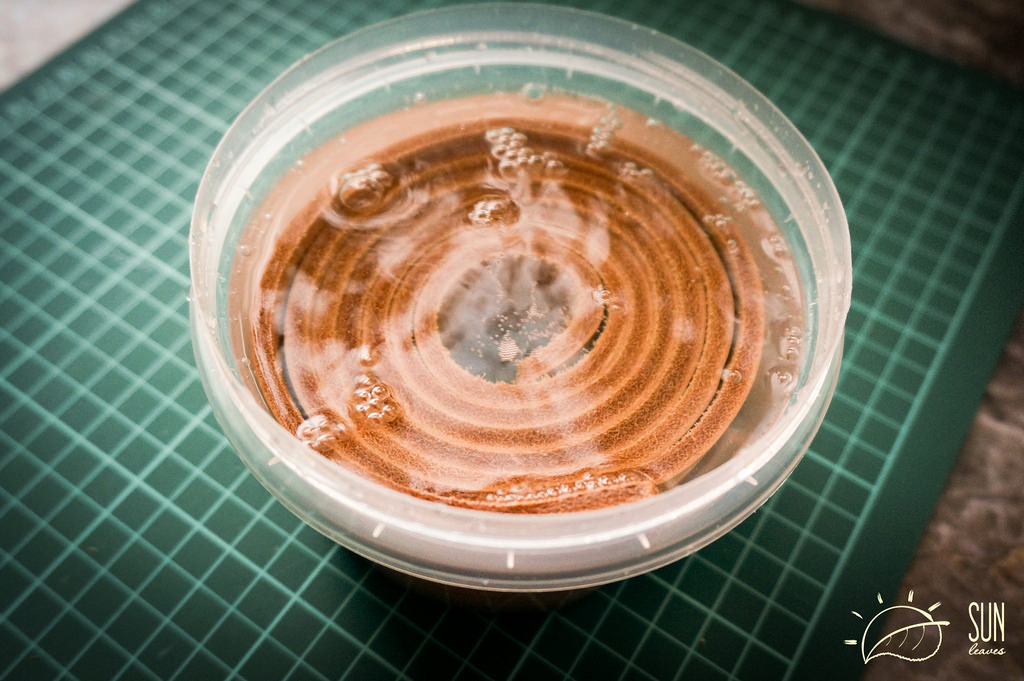
As soon as the bubbles stop coming out, we take our future belt out of the water and let the excess water drain. Then we roll the workpiece, put it in a plastic bag and put it in the refrigerator for a day or two. This is necessary so that the moisture is evenly distributed to the skin. It is important that the package is not hermetically sealed, and excess moisture evaporated - leave a small gap so that the skin can “breathe”. As a result of this lying in the refrigerator, the humidity of the belt will automatically adjust to the desired state and we can proceed to further steps - marking and embossing.
Stage 2 - Marking
We prepared our belt, soaked it and kept it in the refrigerator for several days. Now you can take it out and apply markings. This drawing is very simple - a cage. so I used a ruler and a metal stylus (a needle with a rounded end). If the design is more complex, then you can print it on paper, attach it to the belt and simply trace it with a pencil. The skin is so pliable that all your lines are simply imprinted.

And so that these lines do not get lost during embossing and to emphasize the contour, we trim it with a special rotary knife to a depth of 1-1.5 mm
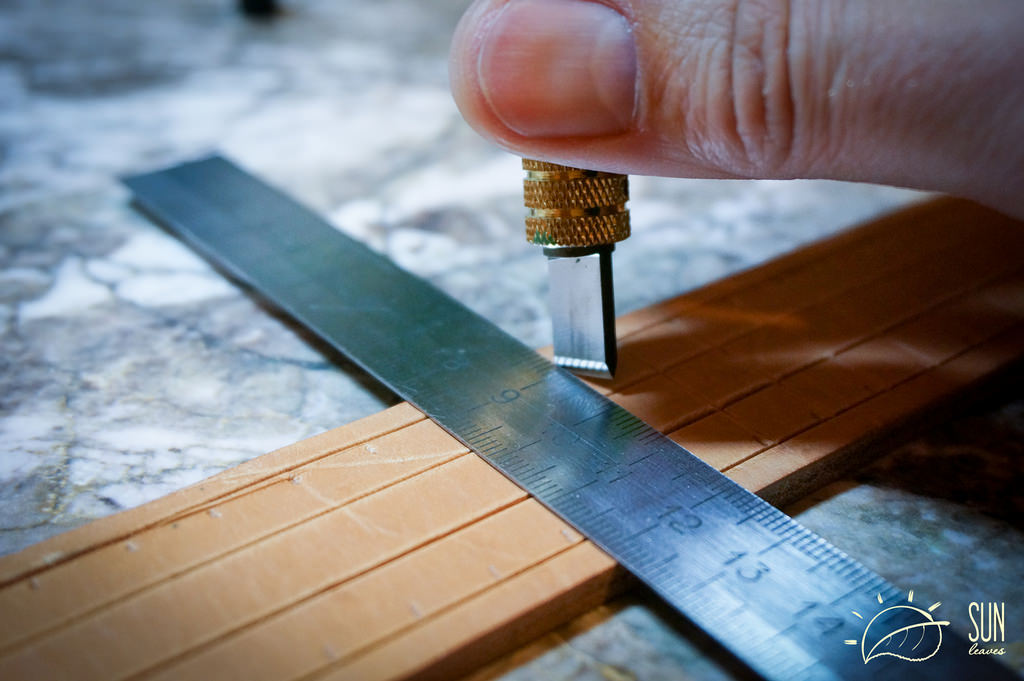
In principle, at this point the marking stage can be considered complete. While we were making the markings, our skin had dried a little, the front surface had acquired its original color, but at the same time the skin was still wet (if you touch your cheek it feels cool to the touch) and this is an ideal state for embossing. Now here’s some advice - since further embossing will take some time, so that the leather does not dry out completely, you can wrap it in film (stretch) and open it gradually by 10-15 centimeters.
Stage 3 - Embossing
Embossing is best done on a solid, smooth and durable surface. A granite or marble slab is ideal for this. We also need a mallet (wooden or rubber - weighing 300-500 grams) and leather stamps.

IN in this case Only one Beveler was used - it has one edge beveled and this allows us to slightly lower the edge of our drawing at the contour.

The Beveler should be placed vertically and lightly hit it with a mallet; the penetration will be organized on its own. Then we move it a few millimeters and hit it again with a punch... and so on along the entire contour. And to get a weaving pattern, we simply deepen it in different directions for different faces of the cells

and so on gradually until the very end. This takes several hours of pure time, but no one is stopping you from dividing the work into several stages. Between stages, store the workpiece in a tightly sealed bag in the refrigerator. Since we wrapped the strip in film, it does not dry out and can easily be stored for a month or more.
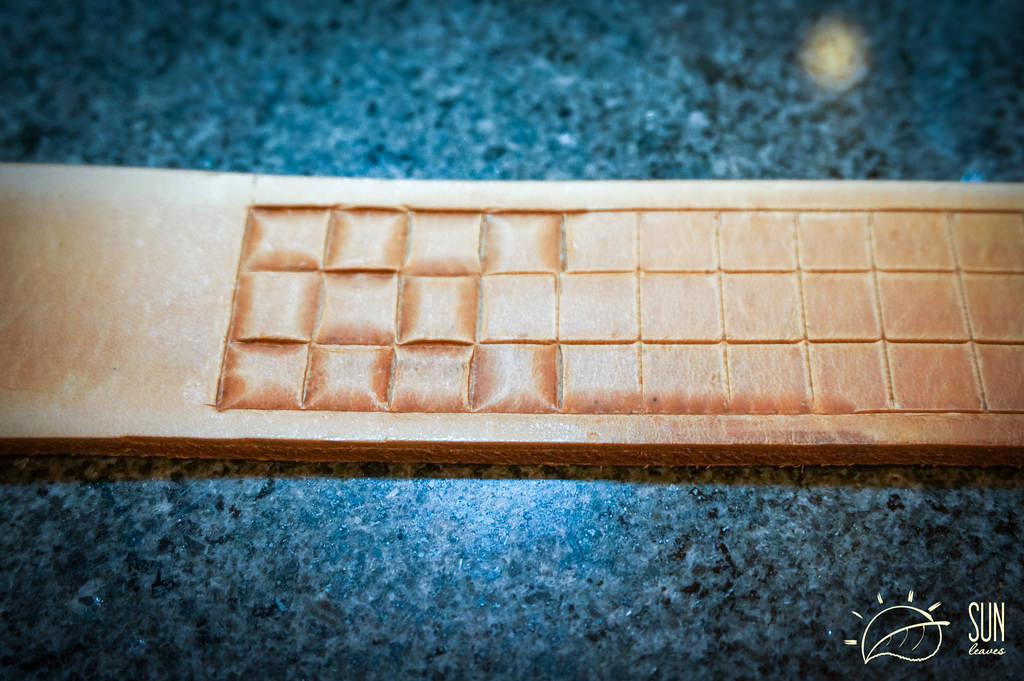
When the entire pattern is completely extruded, our belt begins to take on the appearance of a product. Leave the workpiece overnight until completely dry. After which you can proceed directly to making the belt.
Stage 4 - pruning
Cut the desired length and trim the end. I use a regular cardboard template that I made myself.

We mark the holes where future holes will be - just prick them with an awl. Again, this is easier to do using a template.
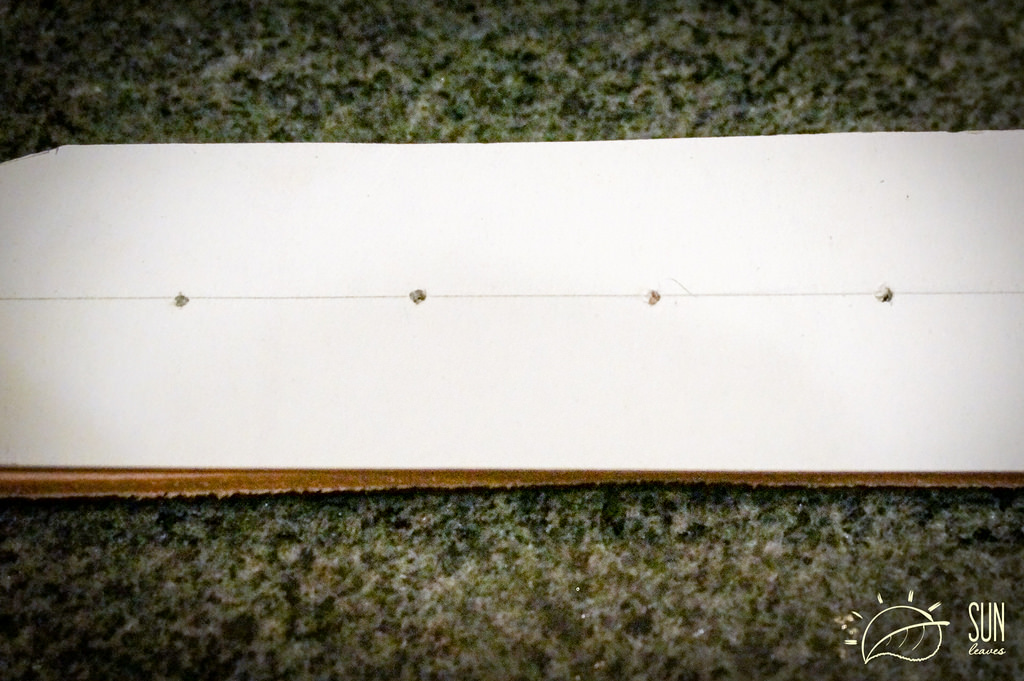
then we punch the holes with a punch. Can be used round required diameter, but for thick belts, I prefer oval - so that the belt does not bend so much when the tongue is inserted into it, and it also looks better.
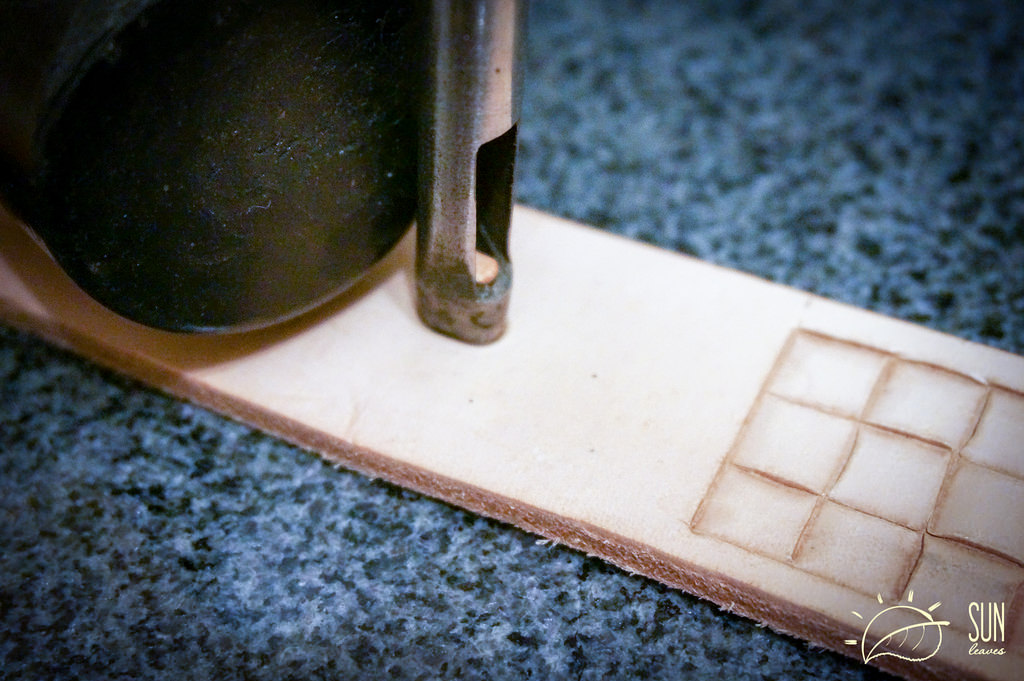
The skin is thick and it took a lot of effort to punch holes.
IMPORTANT POINT - if you plan to paint the product with penetrating dyes, then the holes must be punched after you paint the belt, otherwise the paint will pour into the holes and you will have an ugly blot on the back side.
But I painted in places and only tinted with Antique paste. so I punched the holes in advance
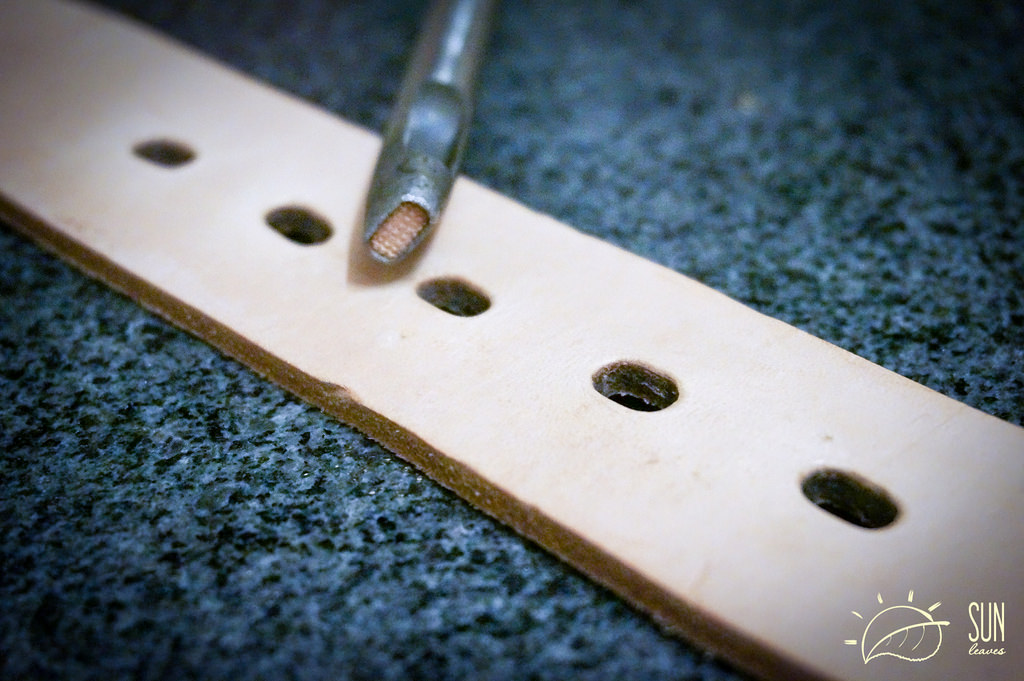
Also marks the location for installing the buckle and punches the installation hole for the tongue using an oval punch
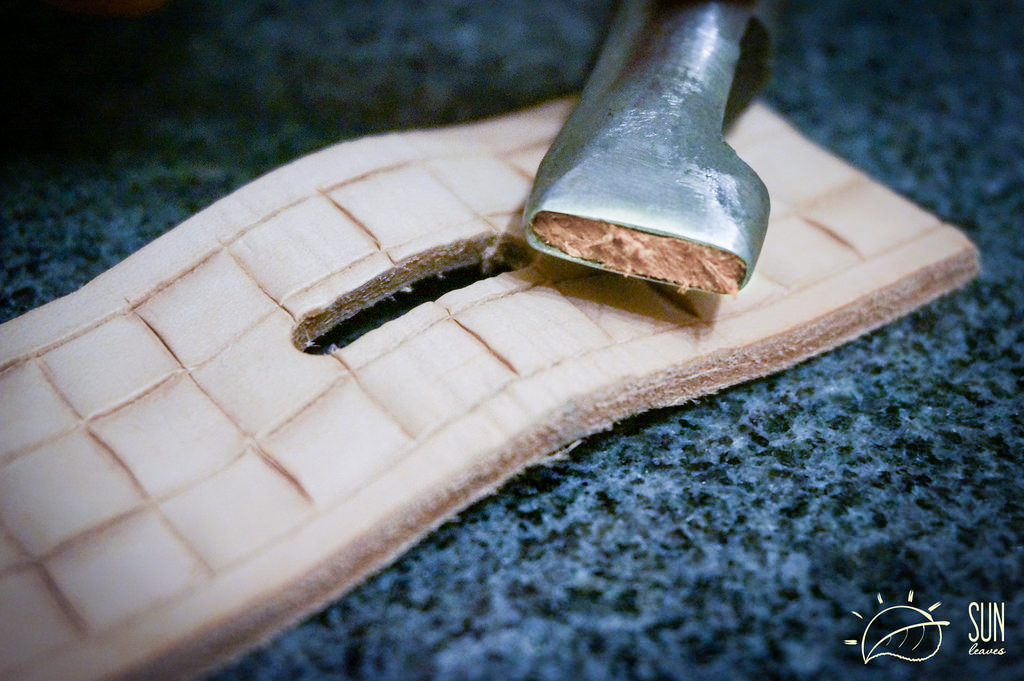
Then personalization - since I was making a monogrammed belt, I wet the end of the belt a little and embossed the initials of the future owner using 1/2 inch tall letter stamps

Then, using fine sandpaper (120 and 140), I leveled the end of the belt

and applied (displaced) a decorative edge
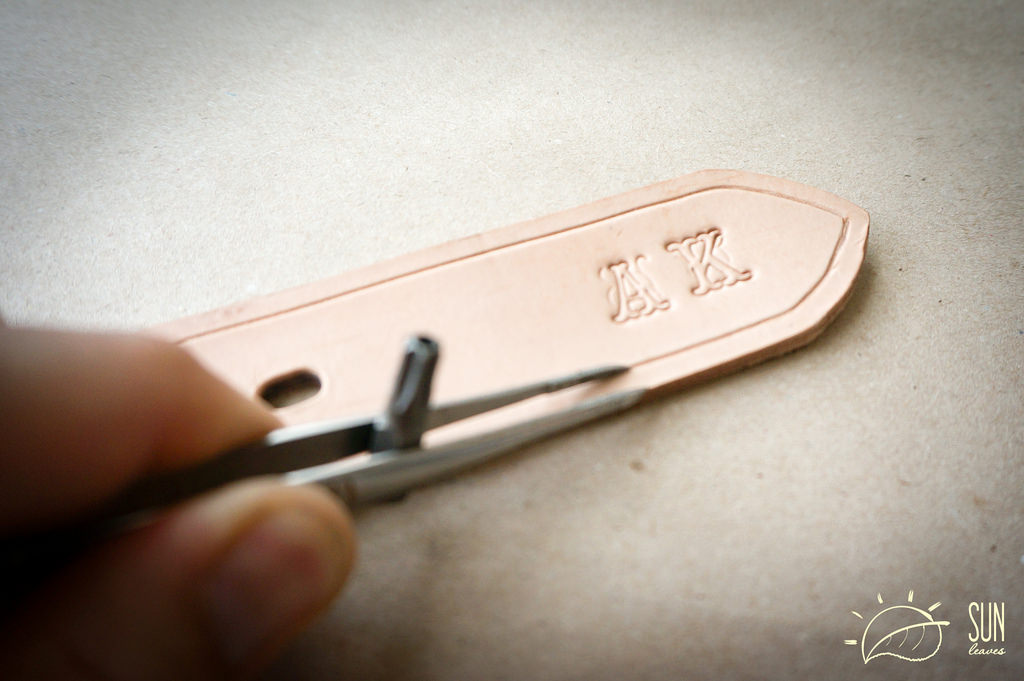
And the last operation of this stage is to thin the tip of the belt that will attach the buckle. Using a sharp enough utility knife, cut off half the thickness of the skin.
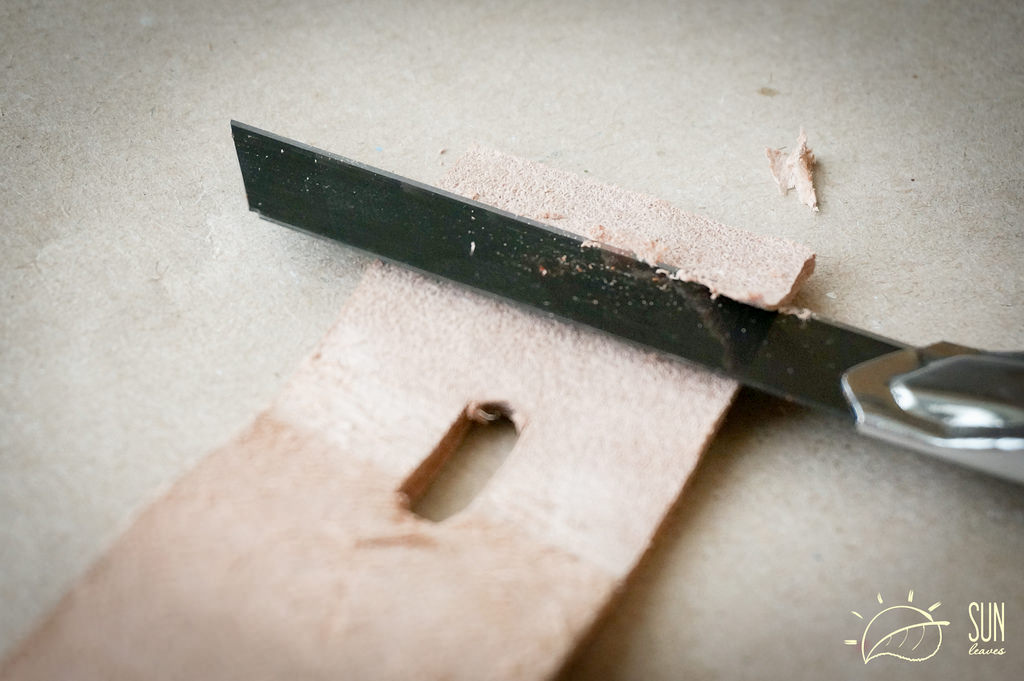
Like this

Our product has almost become a belt. All that remains is to paint it and bring it to its final form.
Stage 5 - coloring
According to the plan, the pattern on the belt should imitate weaving. Using embossing, we gave it a relief, now we will tint the squares as if woven into vertical stripes of leather of a darker tone.
I used penetrating leather dye on alcohol based. It was purchased at a shoe store called simply “rust.” And despite the fact that it was very affordable, the quality turned out to be quite good. You can use any like this

I recommend using gloves (so that later all your hands are not the color “rust”). Using a thin squirrel brush, we begin to carefully paint over the squares in a checkerboard pattern.

Painting is a very simple procedure and does not take very long, but the paint still evaporates and smells strongly, so work in a well-ventilated area
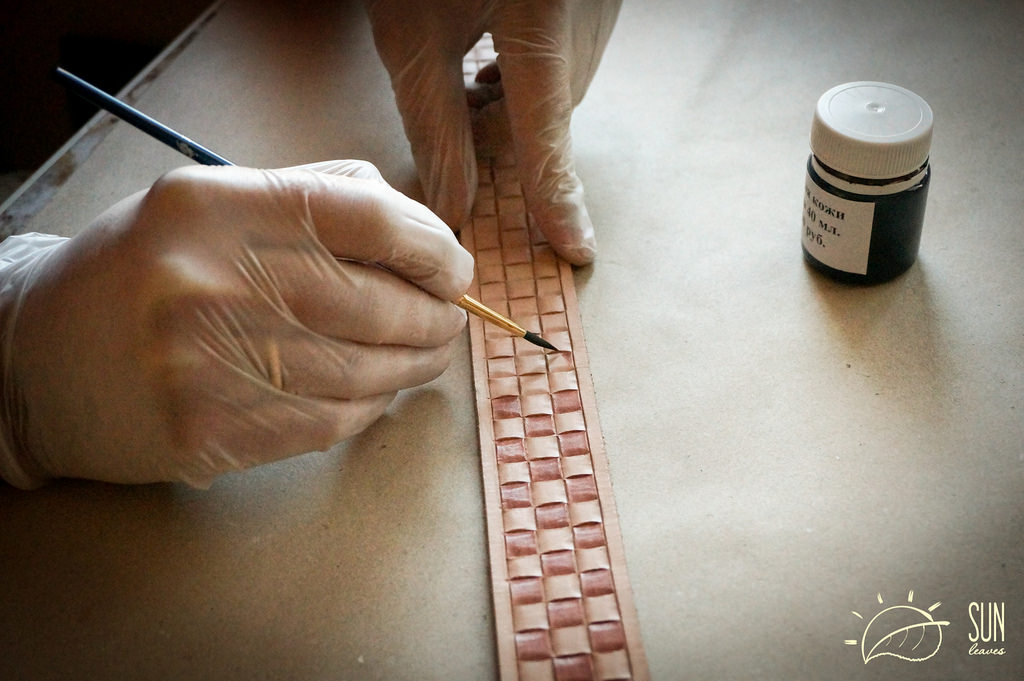
I first dipped the brush directly into the jar, but the smell was very strong, so I decided to pour it little by little into the jar. large quantities into another container. I decided to use a regular school palette for paints. Using a pipette, I poured a little into one of the compartments and, if necessary, added a couple of times. It turned out great solution: less consumption, less smell, and is much more stable on the table.
Very useful technique, I will actively use it
After painting the cells, I brushed the paint around the perimeter - for this it turned out to be more convenient to use a cotton swab. This is what happened as a result
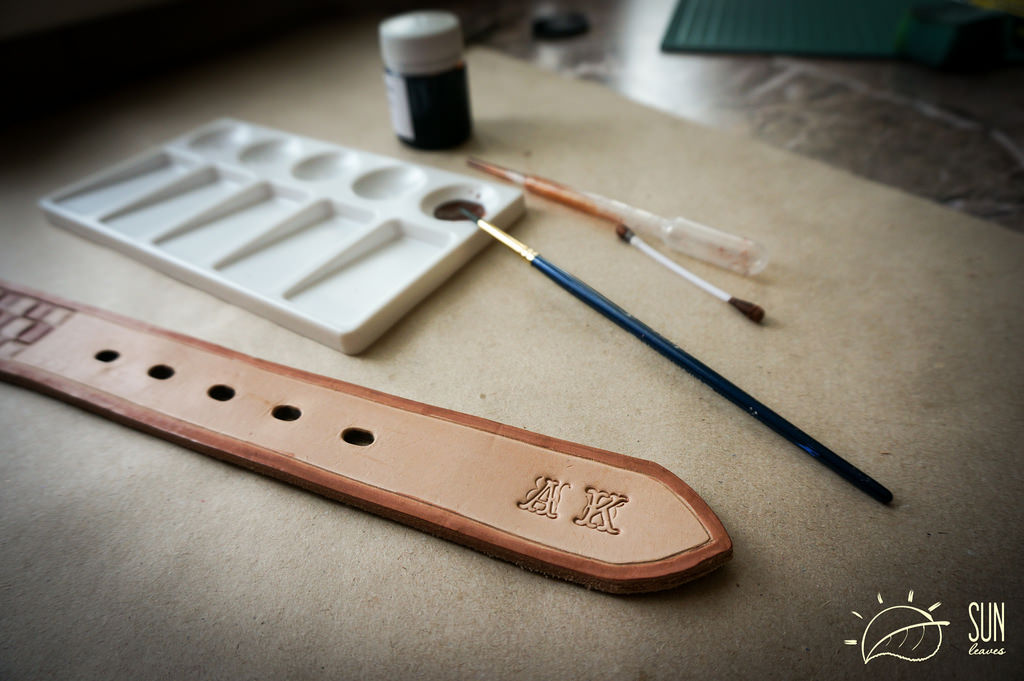
The next step will be tinting and in order not to stain the inner surface, I sealed it with masking tape.

For tinting I use Cordowan antique paste. I ordered this paste from a Japanese online store. applied with a toothbrush - the hard bristles of which allow you to paint over all the indentations
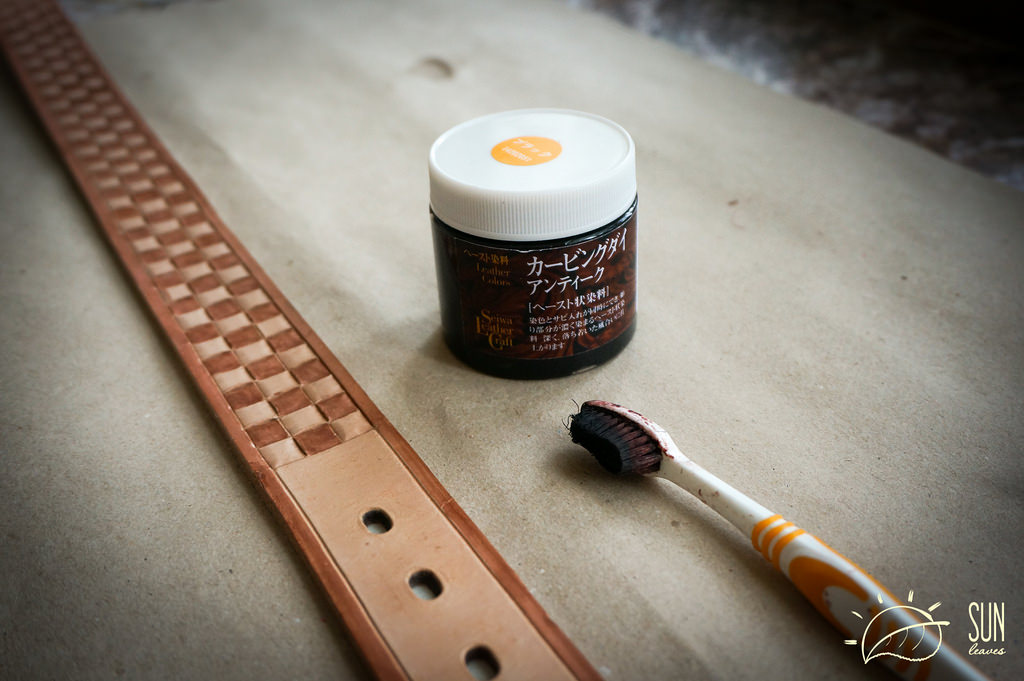
put a little on the brush
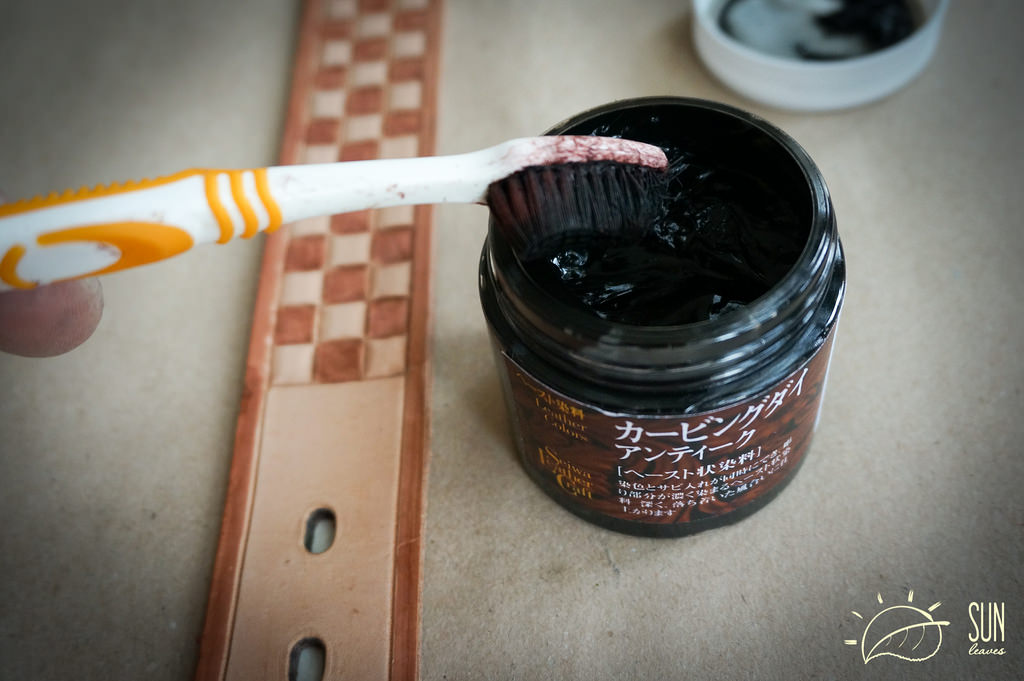
and rub evenly over the surface, painting each cut
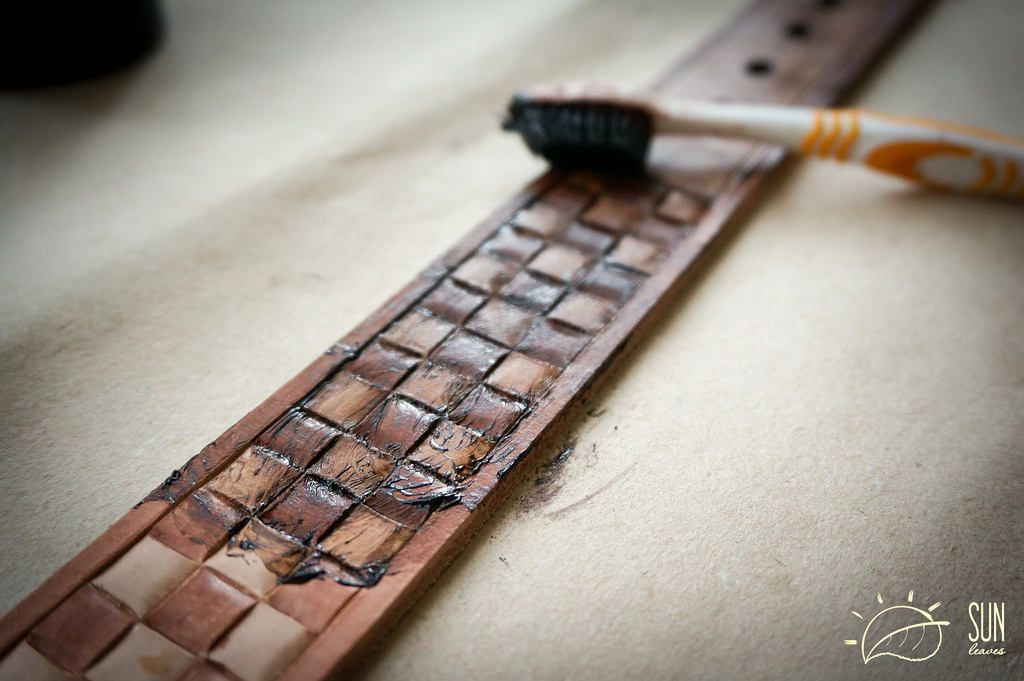
Antique paste is a dye on water based, but very thick - it does not penetrate the skin so deeply and does not dry out so quickly. While the paste is not completely dry, remove excess with a dry cloth.

If necessary, you can reduce the intensity of the color by moistening the cloth a little. Using antique paste, we did two things at once - we tinted the entire surface and emphasized the embossing relief. Next, wait until it dries completely and polish with a dry soft cloth, remove the tape from reverse side and you can proceed to the next stage
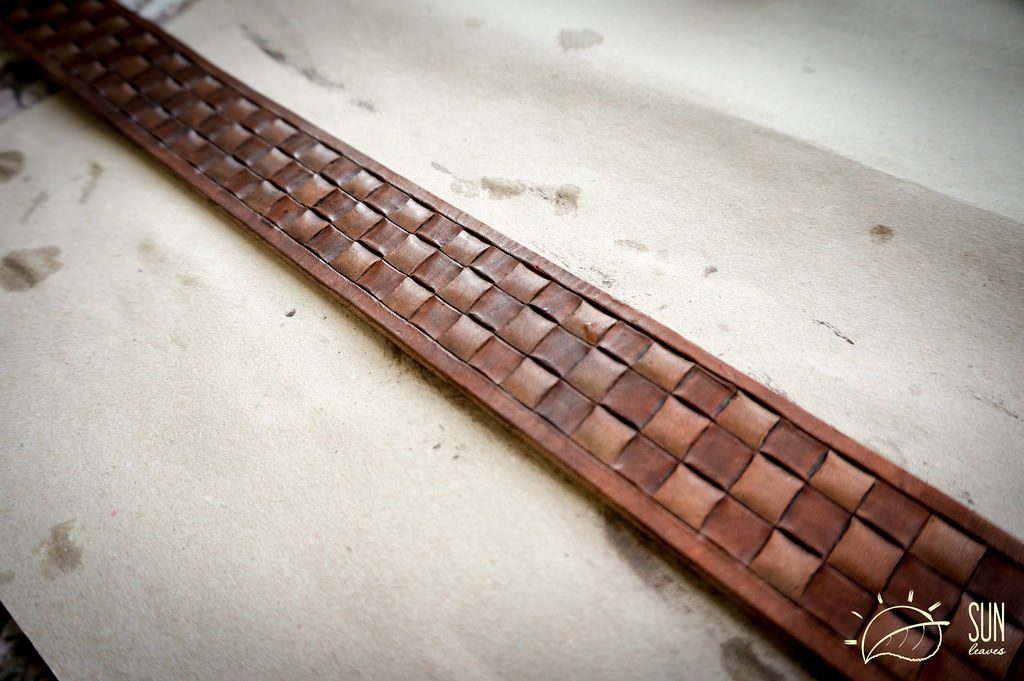
Stage 6 - end processing
The processed end is a very important component appearance products. If the end is not processed and polished, then the belt looks like a cheap craft.
First you need to cut off the corner of the edge. For this we use special tool— edge cutter (totsbild).
![]()
It can be used to cut an edge on one side

and on the other
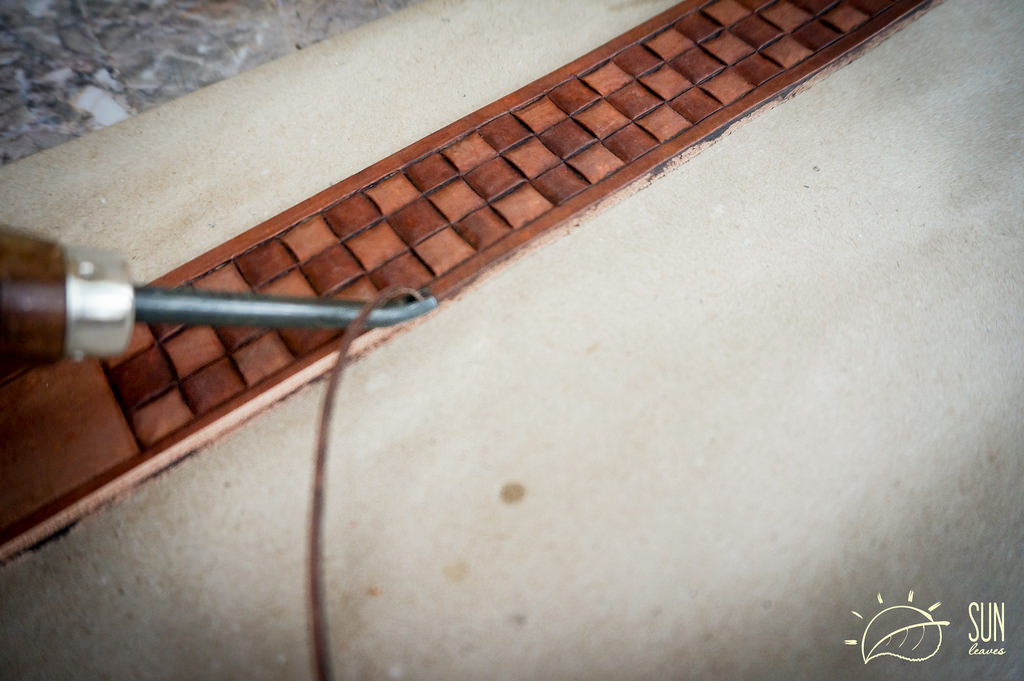
I used an edge cutter with a semicircular profile with a radius of 2 mm

Having walked along the perimeter on both sides, we got an almost round end. In theory, you can process the end using sandpaper, while I did not have such an edge cutter, I used wooden blocks and sandpaper rounded the edges, but this is very labor-intensive and still difficult to do as neatly and evenly
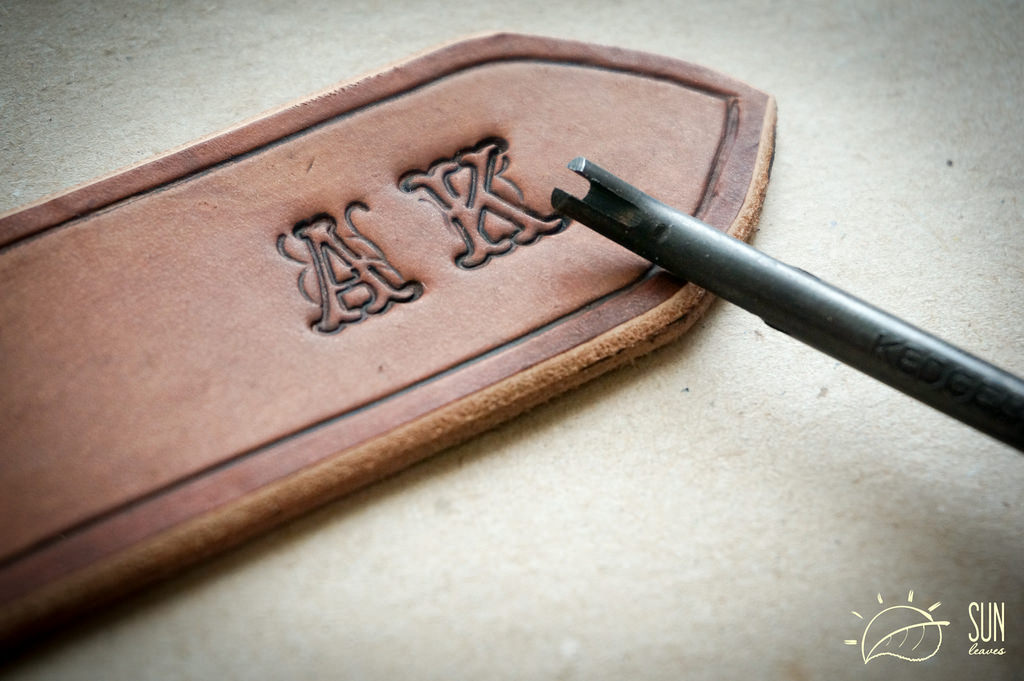
Now let's smooth it and polish it (using water and a slicker)

apply a little water to the end with a sponge (it’s even better to moisten it with saddle soap, but if you don’t have it, or you will treat the end with additional compounds, then you can just use water)
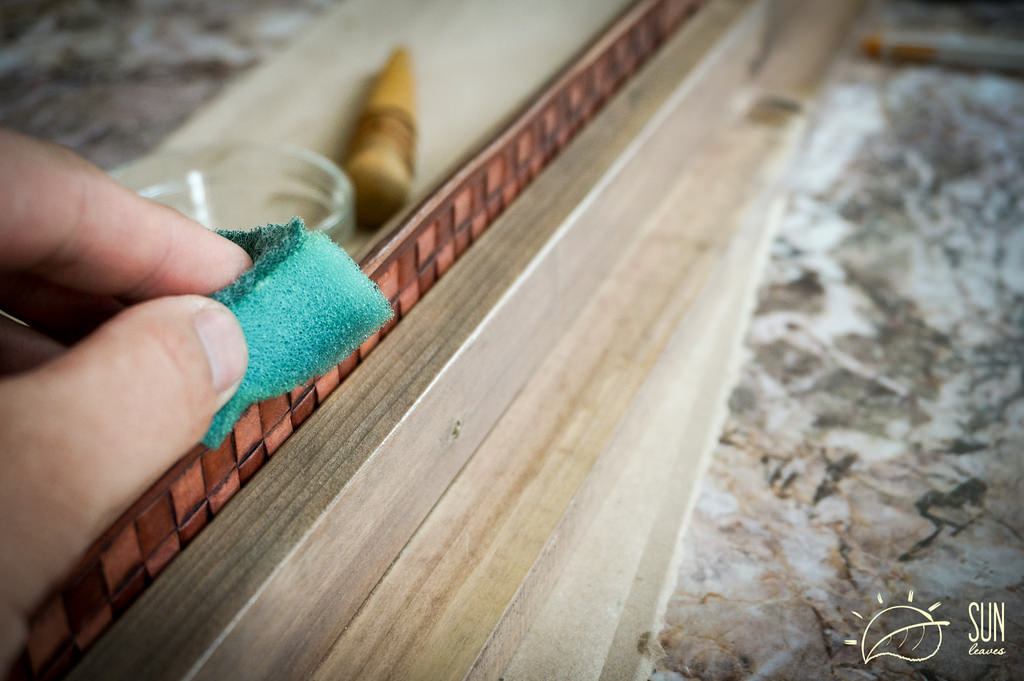
And using a smoothing iron we polish the end.

The difference is already visible, and sometimes that’s enough, but we’ll go further
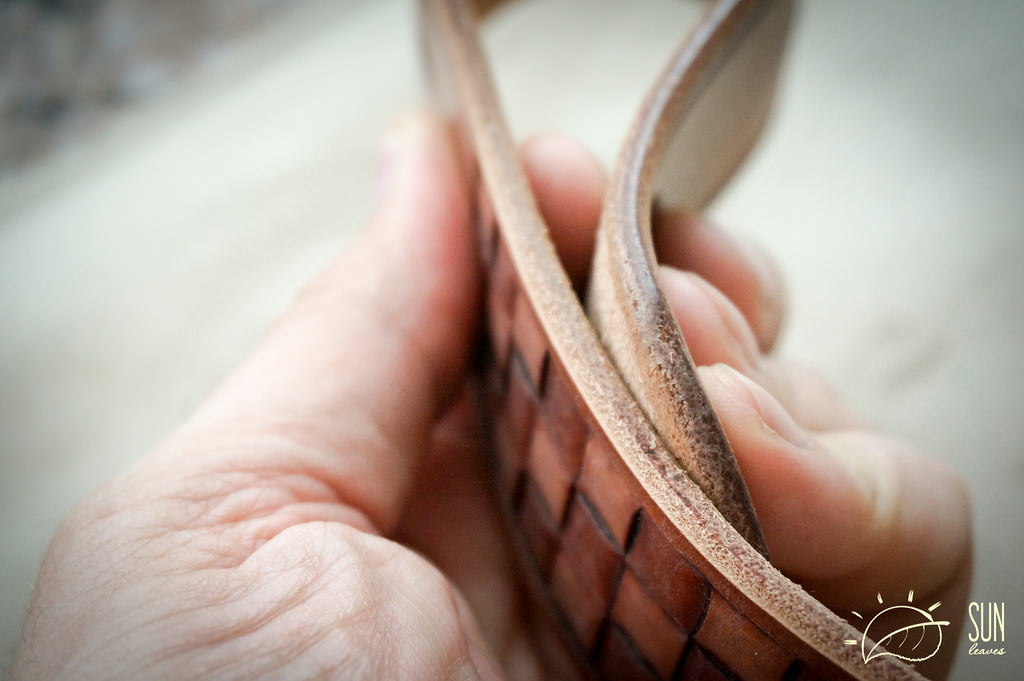
for final processing of the end, you can use wax-based pastes or use Tragant Gum - this special composition(by the way, it is even used in Food Industry) it fills all the pores but remains elastic. It was purchased from the same Japanese online store.
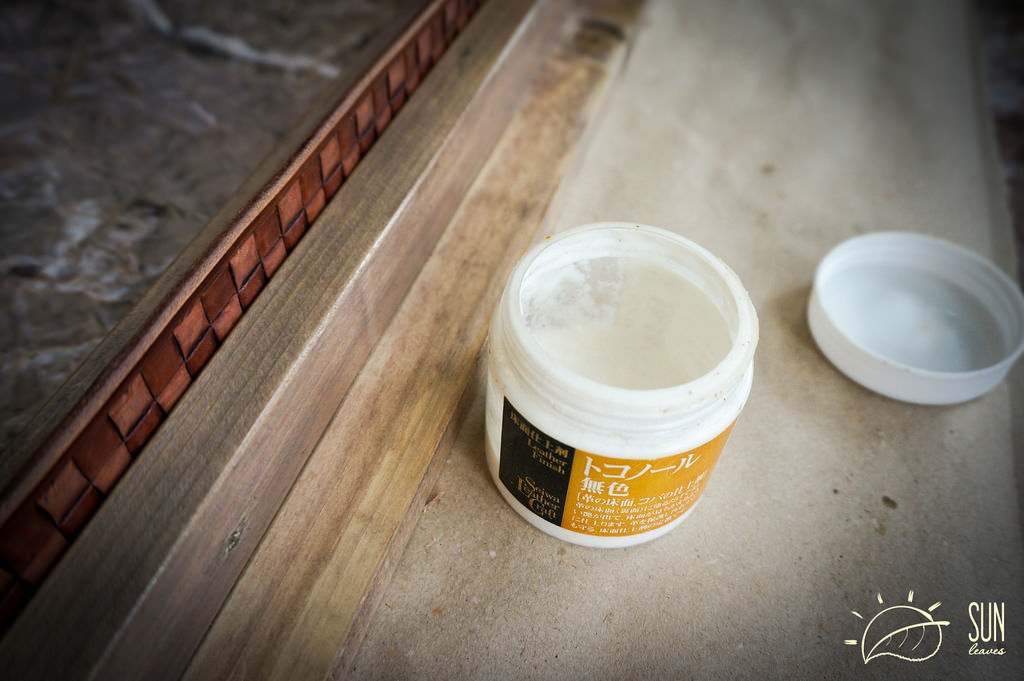
Apply a small amount evenly to the entire surface of the end and

and go through the slicker again.

There is very little left to do - install the buckle and cover the entire belt with the finishing coat.
Stage 7 - installation of fittings
Due to the fact that the painting was partial, we already made a hole for the buckle in the previous stages. But most often it is at this stage, after finishing all the painting, that we would mark and punch all the holes.
The buckle will be attached using rivets (holniten) - that is, we need to attach the buckle and punch three more holes
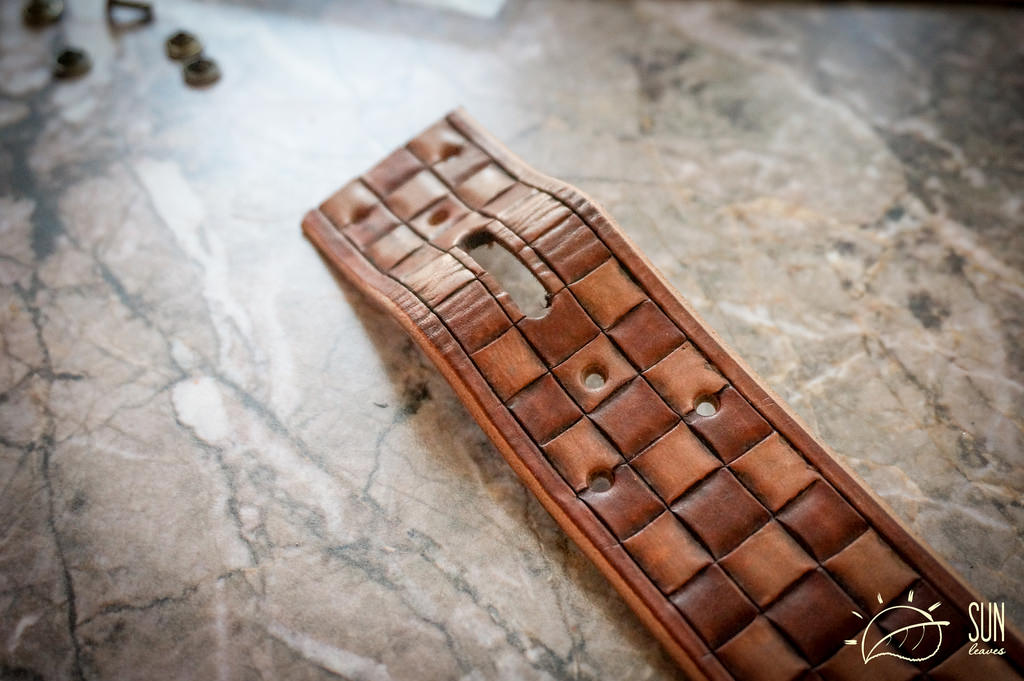
44.
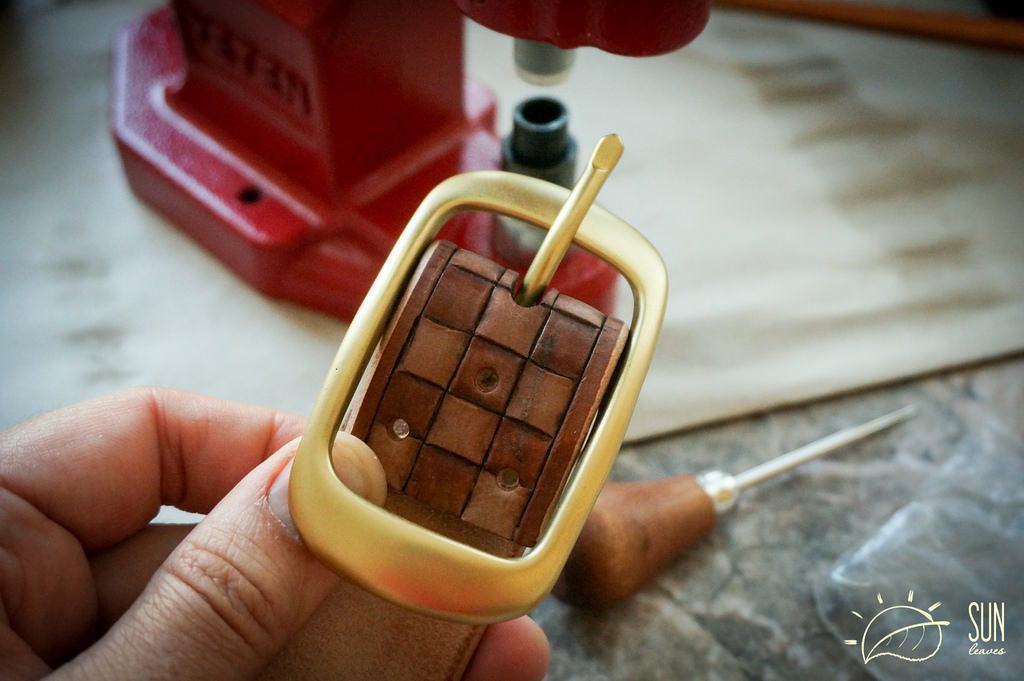
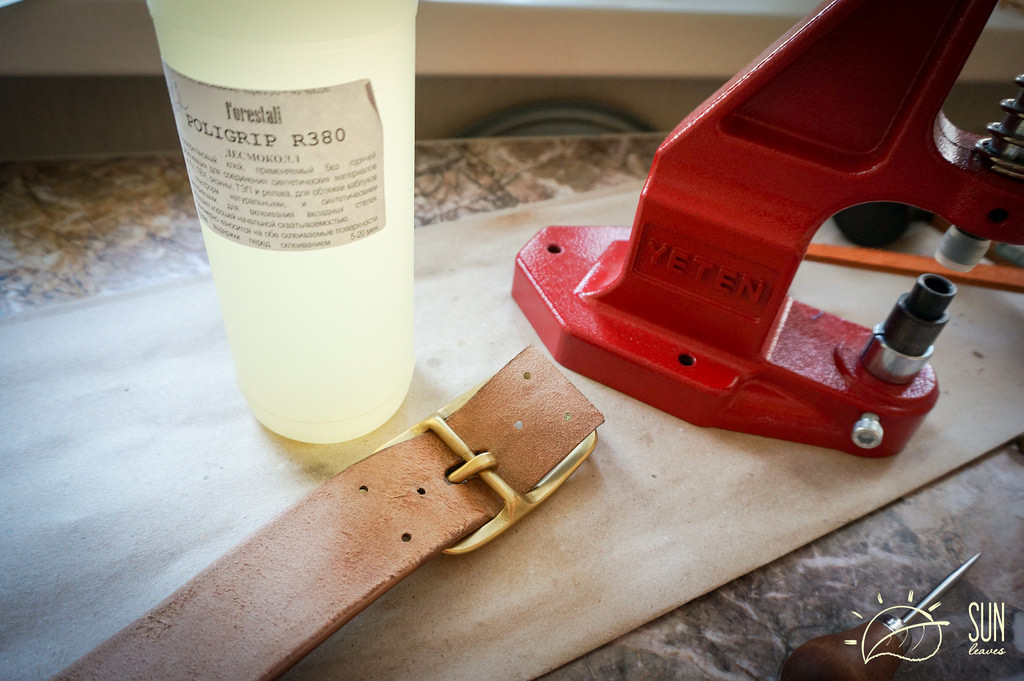
To make the fastening neat, we will additionally glue it.
I used Desmokol cold activated polyurethane adhesive. But you can use any contact adhesive suitable for gluing skin. Let's coat the gluing areas and wait 10 minutes.
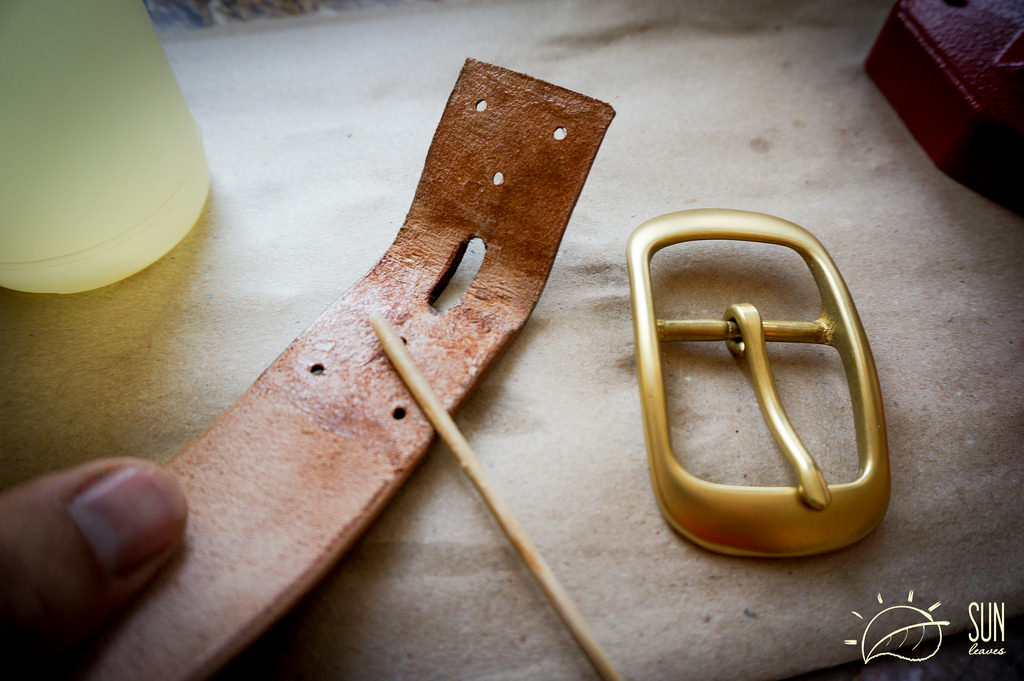
Then carefully assemble the buckle and install the holnitens. I used a hand press - but you can also do this with installer's pliers.
And if there is neither one nor the other, you can use ordinary belt screws.
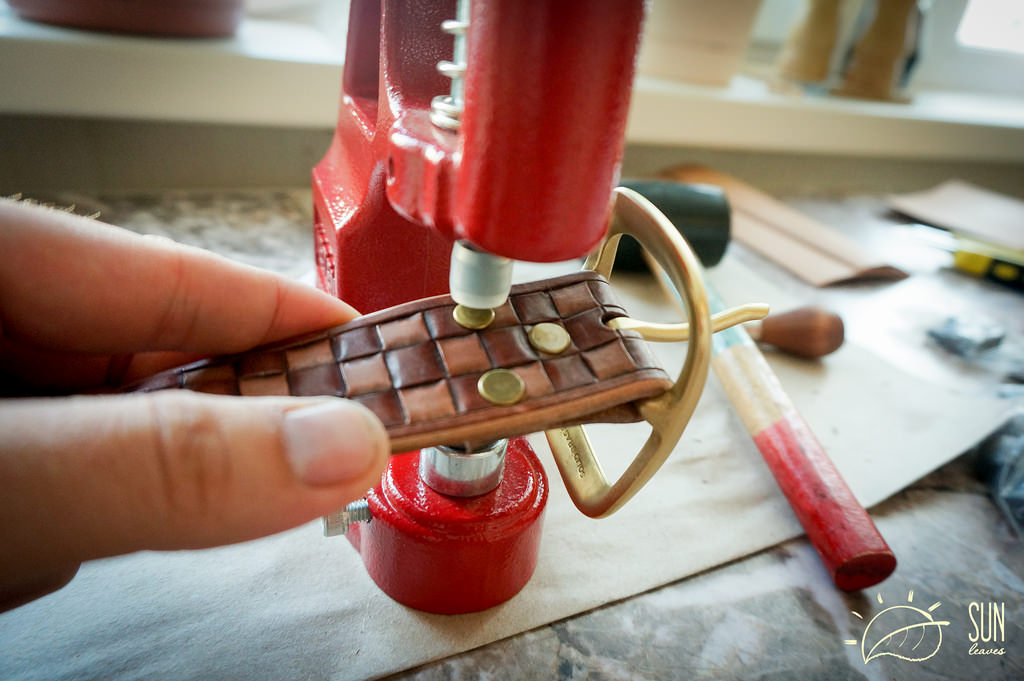
To ensure that the gluing area was completely even, I held it in the clamps for 5 minutes
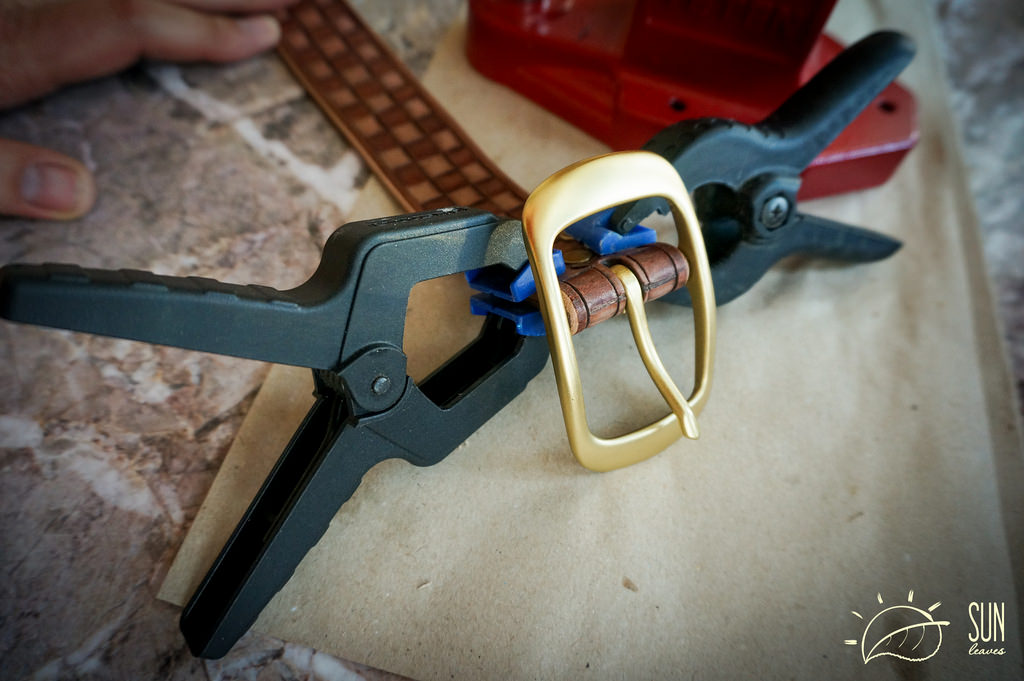
Stage 8 - finishing coat.
This is already the most final stage. Our belt is completely ready. Finish coating It will simply give it additional protective properties.
First, I rubbed the entire belt with hoof oil—it really is oil—which used to be used to soak the leather to give it protective properties. I bought this jar at a store that sells horse tack.
You need to apply just a little on the inner surface and let it soak evenly. This is a little for warming up - so that the belt becomes flexible. Here you can carefully go overboard. This is how I do it: apply it to a cloth, touch it along the entire length of the belt in increments of 5-10 cm and rub out the blots. Let it soak evenly (it’s best to leave it overnight)
I also lightly wipe the front surface
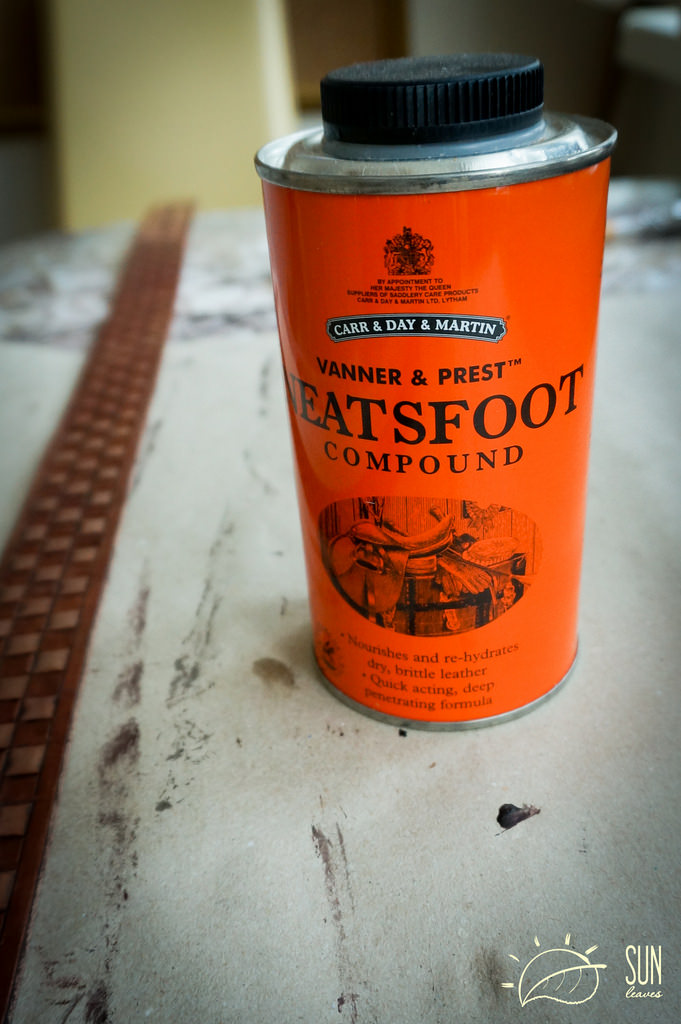
When the oil is completely distributed, cover with any finisher. For belts, I prefer to use Risolin - Flieings resolene (it is also water-based) and creates a smooth, thin, glossy film that will protect the belt from fading, abrasion and also give it water-repellent properties.

The cost is difficult to determine since I used tools and professional products which are expensive in themselves. Without them, it either didn’t work out at all, or the work took several times longer.
I hope that this masterclass was useful to you.
Visit my page at
If we talk about the clothing market, one of the most interesting business segments is the production of clothing accessories. This line of activity can be called simple, but at the same time, the cost of such products is quite high and their popularity does not fade away every year. In this article, we propose to study in detail one of the areas of sewing - the production of leather belts. We hope that the information we provide will benefit both beginning entrepreneurs and those businessmen whose business is already represented on the market.
The role of each accessory is to decorate clothes, add some additional zest to the image, brighten it up, emphasize advantages or hide flaws. Therefore, each accessory must have certain requirements, including uniqueness and style. But the most important thing for an entrepreneur is that the resulting product does not differ at a high price, and at the same time could bring good financial results.
Benefits of producing leather belts
Today, it is more than profitable for our country to produce leather belts. And this statement is easy to verify. The belt is the most popular accessory in Russia; consumers use it for everyday wear and for festive occasions, often not only men, but also women and children. This means that a leather belt has no restrictions either on the age or gender of those people who actively use it. A huge range of consumers provides room for active action, and the market is constantly changing. Just a few years ago, the sale of belts could be divided into two categories:
- branded belts from popular European brands;
- cheap Chinese fakes.
Today it should be noted that the situation has changed dramatically; now the middle segment of the business is actively developing, which offers goods of European quality to the market, but with prices that are more affordable for consumers. This activity of entrepreneurs is associated with an increase in demand from Russian consumers for handmade products and with good quality. A rather positive conclusion follows from this: our country has joined the trends of world fashion and today we can observe such a stage as the popularization of handmade products. Based on the practice of developed countries of the world, this trend should be observed in the coming years, and demand should continue to increase by approximately 30 percent annually, thereby ensuring development homey look management and organization of mini-businesses.
Three fundamental elements of a successful business:
- demand – in this type of business it is planned to further increase (as was already noted earlier);
- a set of organizational measures - organizing the production of leather belts requires a working area of about 10 square meters. m. and several types of equipment;
- investment in business - money will be needed to purchase raw materials.
Important. The profitability of a business producing leather belts can be 300-1000 percent. Such indicators are quite difficult to find in any other areas of activity.
Technological process
The technology for making a genuine leather belt can be of two types.
First view technological process. Production of multilayer products. Involves the use of three components:
- The front part provides for the use various types skin, including expensive materials, such as ostrich or snake leather, as well as more budget ones, such as pig, goat, etc. The choice of material can be very diverse and mainly depends on what final selling price is planned to be set, and what level of presentability should be achieved during production products.
- The lining is always low-grade leather or even its artificial substitute, the so-called leatherette. The lining is necessary in order to maximize the service life of the finished product, otherwise the belt will have low wear resistance and its quality will suffer significantly.
- The bottom layer is usually pigskin. Its use guarantees more high quality finished product, since pork skin is very strong and durable, and in addition has a number of other advantages, including low cost.
The technological process for producing a three-layer belt is as follows:
- Cutting workpieces to the required size.
- Gluing all layers so that the lowest layer is folded into the middle. For sizing, it is most convenient to use a press, which significantly improves the quality of the process.
- Firmware around the perimeter of the product.
- Embossing and engraving, hole punching.
- Painting the finished product, sanding it.
- Assembling all parts into a single whole
The method described above involves both gluing and stitching of the belt, thus achieving the maximum high result regarding the quality of the finished product. Typically, production uses only one of the methods for connecting layers of a product in order to reduce the time of the production process and reduce its cost. But we should not forget that quality will certainly suffer from such an approach.
The second type of production is the production of a single-layer belt. This option is much simpler than the one described above and involves going through the following steps:
- product pattern;
- punching holes;
- Carrying out engraving and embossing work;
- sanding edges;
- coloring;
- assembly (installation of rivets and buckles).
Single-layer belts, unlike multi-layer ones, are not considered classic, but today they are at the peak of popularity because they have found their use with jeans. Moreover, many consumers began to use them with traditional clothing.
Equipment for setting up belt production
The amount of equipment is directly proportional to the goals the entrepreneur sets for himself. To establish full production of leather belts up to several hundred copies finished products per work shift, you will need the following list of devices and equipment:
- press (automatic or manual);
- automatic machine for installing decorative elements;
- automatic machine for rounding seams;
- machine for cutting parts;
- automatic machine for engraving and stamping;
- automatic painting machine.
To buy all this new equipment you will need at least 500 thousand rubles. You can save a lot if you buy used machines rather than new ones, or choose machines with a manual drive rather than an automatic one.
But if we talk about the full purchase of all professional equipment, then it will be necessary to take care of such issues as premises or hiring personnel, which is also important when organizing a full-fledged workshop.
As a result, the invested funds and efforts may not bring any positive results, because in this case you can forget about such important production qualities as mobility of production and the uniqueness of the product.
We want to draw the attention of entrepreneurs to the attractive aspects of a mini business, which can be organized at home, where production process no more than one or two people are employed, and the production of belts itself is not put on stream, but is of a purely individual nature. Making unique accessories occupies a completely different niche in the market and can avoid the most basic problem of any business - competition (often with Chinese low-quality products).
In this case, the business plan looks completely different. And to implement it, you will need to purchase the following equipment for the production of belts:
- sewing machine – 18 thousand rubles;
- press – 5 thousand rubles;
- tools for embossing – 10 thousand rubles;
- knives – 5 thousand rubles;
- grinding machine – 10 thousand rubles.
The total investment in the purchase of equipment is 48 thousand rubles. But again, costs can be reduced if you buy not new, but used equipment, and some machines, for example, a press, can even be made independently using a homemade method. But what you shouldn’t save on is buying knives and embossing tools.
Premises for organizing production
To organize your own mini production, an area of no more than 15 will be enough. square meters, so a room in an apartment may well be suitable for these purposes. The only point worth paying attention to is the stage of painting the finished product. You should not produce it in a residential area, as this is fraught with problems with your health and the health of your family. To paint belts, you can use a garage or other outbuildings with good ventilation.
It is this kind of handicraft work that is very popular today, that is, the product that is in demand on the market is the one that was made using the most manual options processing and primitive production technologies. And it is precisely this production option that can claim success in the market today.
Business profitability
In order to find out the profitability of the business, it is necessary to calculate the cost of the belt.
For example, let’s calculate the cost of an ostrich leather belt:
- ostrich leather – 4 sq. dm. at a price of 170 rubles/sq.m. dm. – 680 rub.;
- buckle – 1 pc. – 200 rub.;
Cost: 1.01 thousand rubles.
The selling price of the finished product is 6 thousand rubles.
Net income – 4.99 thousand rubles.
In order to pay off all investments in the business in the amount of 48 thousand rubles, it is enough to produce only 10 such belts.
Calculation of the cost of a calfskin belt:
- leather cardboard – 4 sq. dm. at a price of 10 rubles/sq. dm. – 40 rub.;
- split wood - 4 sq. dm. at a price of 5 rubles/sq. dm. – 20 rub.;
- buckle – 1 pc. – 200 rub.;
- fastening – 3 pcs. at a price of 20 rubles/piece. – 60 rub.;
- electricity costs - 10 rubles.
Cost: 410 rub.
Sales price – 2 thousand rubles.
Net profit – 1.59 thousand rubles.
If single-layer production technology is used, the cost of a belt made of high-quality calfskin will be:
- knob – 4 sq. dm. at a price of 20 rubles/sq. dm. –80 rub.;
- buckle – 1 pc. – 100 rub.;
- fastening – 3 pcs. at a price of 20 rubles/piece. – 60 rub.;
- electricity costs - 10 rubles.
Cost: 250 rubles.
Selling price – 600 rubles.
Net profit – 350 rubles.
If we take into account that the production of one belt will take on average about two hours, then 4 belts can be produced in a working day. And the net profit in this case will be 1,400 rubles.
Cost of a cheap leather belt:
quality cattle leather will be:
- knob – 4 sq. dm. at a price of 5 rubles/sq. dm. –20 rub.;
- buckle – 1 pc. – 50 rub.;
- fastening – 3 pcs. at a price of 10 rubles/piece. – 30 rub.;
- electricity costs - 10 rubles.
Cost: 110 rubles.
Selling price – 200 rubles.
Net profit – 90 rubles.
From these calculations it can be concluded that home production can quite successfully compete even with Chinese products. And this doesn’t even take into account the fact that if you buy raw materials in large quantities, then it will Wholesale prices will be much lower than retail prices.
We are looking for suppliers
It is not worthwhile to engage in leather tanning yourself, because it will require a lot of additional costs and time, which will not be justified in financial terms. But it’s also not worth purchasing low-quality raw materials. Therefore, an entrepreneur should definitely think about finding permanent suppliers. In practice, this is not so difficult to implement. You just need to study in detail the information regarding the reputation of potential candidates in terms of the quality of raw materials and meeting delivery deadlines. It is best to immediately establish cooperation with suppliers of leather and accessories.
Important. Leather supplies are carried out not in sheets, but in skins. And the cost of one square decimeter of leather depends primarily on its quality. The average price on the market ranges from 10 to 50 rubles per square decimeter for pork, goat and calf leather. But prices for exotic types of raw materials start from 100 rubles and above.
High quality material
Goat leather is most often used to make quality products. It is very soft, pleasant to work with and aesthetically attractive, it also has a pleasant color, but in terms of wear it requires special care.
Recently, products made from ostrich leather have become very popular on the market. The price of such raw materials is not cheap, but the appearance of the product is very attractive. Exclusive types of leather also include iguana, shark and python. It is best to produce products made from such materials only to order, so as not to end up at a disadvantage.
The craftsman should understand that a lot depends on the quality of the raw materials, so under no circumstances should you skimp on leather. Cheap material and wears poorly and its service life is short, and with low-quality products the entrepreneur may develop a negative reputation, which is unacceptable for business.
Most often, belts are made from pigskin - it is inexpensive and at the same time quite quality material, and for high-end products, calfskin and sheepskin, which have a very long service life, are perfect.
Additionally, you need to worry about high-quality fittings.
Semi-finished products
To save on the purchase of raw materials, as well as significantly reduce the production time of belts, you can agree with suppliers to provide already processed and cut semi-finished products. Such blanks are strips of leather the right size, and they can immediately be used to make belts.
Certification Issues
The production of leather belts does not require certification or special licenses. But if you want to make expensive, high-quality products, you must understand that buyers will need evidence of the quality of the product.
And since getting certified is not difficult, we still advise entrepreneurs to address this issue in order to increase confidence in their products from potential buyers. For this purpose, you need to visit a specialized center and provide samples of your products with the necessary documentation. The certificate is issued to the entrepreneur after passing the examination procedure.
